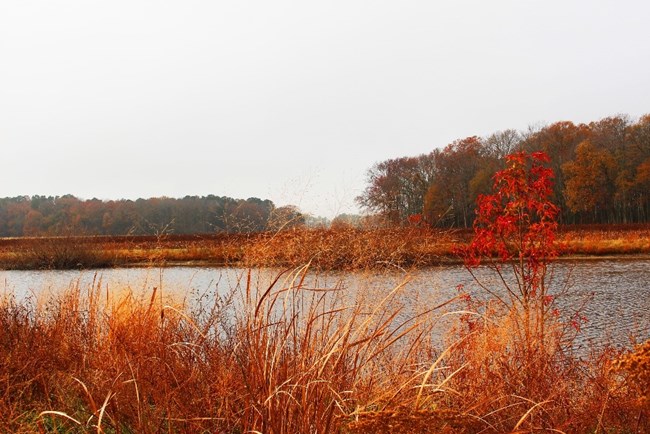Learn about NRCAs
The Natural Resource Condition Assessment (NRCA) Program provides framework, funding, and publishing support to parks to aid in the synthesis and documentation of natural resource conditions. Condition assessment reports are a tool to describe selected park resources, and record a snapshot of their current condition, identify trends, and identify potential or current threats and stressors. Understanding the condition and trend of natural resources is key for parks and NPS planners to appropriately prioritize and allocate stewardship resources.

NPS Photo/ Beth Parnicza
Natural resources within the 25,000-acre park include a diverse biota with high ecological integrity, including the presence of the federally listed northern long-eared bat (Myotis septentrionalis) and recovered populations of bald eagles (Haliaeetus leucocephalus) and Delmarva fox squirrels (Sciurus niger cinereus). Forest resources are abundant but may be at risk from an overabundance of the nonnative Sika deer (Cervus nippon). Wetlands are widespread but are threatened by degraded water quality, rising sea level, increasingly intense and frequent coastal storms, and non-native species. Midnight skies and silent stars are an important historical resource but are diminished by light pollution and road noise.
Traditional NRCA Report: 2019
In order to better understand the natural resources and processes in the park, a Natural Resource Condition Assessment was written and published in 2019. Staff from the Harriet Tubman Underground Railroad State Park, the National Park Service and ecologists from the University of Richmond and the University of Maryland collaborated to determine the resources needing evaluation. The NRCA for this park was published in 2019, and evaluated numerous indicators of condition under four overarching resource topics:
- air quality |
||
- water resources |
||
- biological integrity |
||
- landscape dynamics |
Six resources indicators were considered to be in good condition: dissolved oxygen, temperature, Delmarva fox squirrels, bald eagles, forest interior birds, and landcover; four resources indicators were given a condition of moderate concern: chlorophyll a, forest structure, bats, and historic landscape; and the remaining ten resource indicators were given a condition of significant concern: wet sulfur deposition, wet nitrogen deposition, visibility, ozone, water clarity, total nitrogen, total phosphorus, benthic index of biotic integrity, deer, and wetlands. Although the park is currently in good condition for land cover, sea level rise threatens the integrity of upland forests that may turn into wetlands. Existing wetlands, in turn may be lost to open water areas. The park will continue to monitor these park resources, as well as educate the public on resource concerns.
For other reports and natural resource datasets visit the NPS Data Store.
Source: NPS DataStore Collection 7765 (results presented are a subset). To search for additional information, visit the NPS DataStore.
Last updated: June 29, 2022
